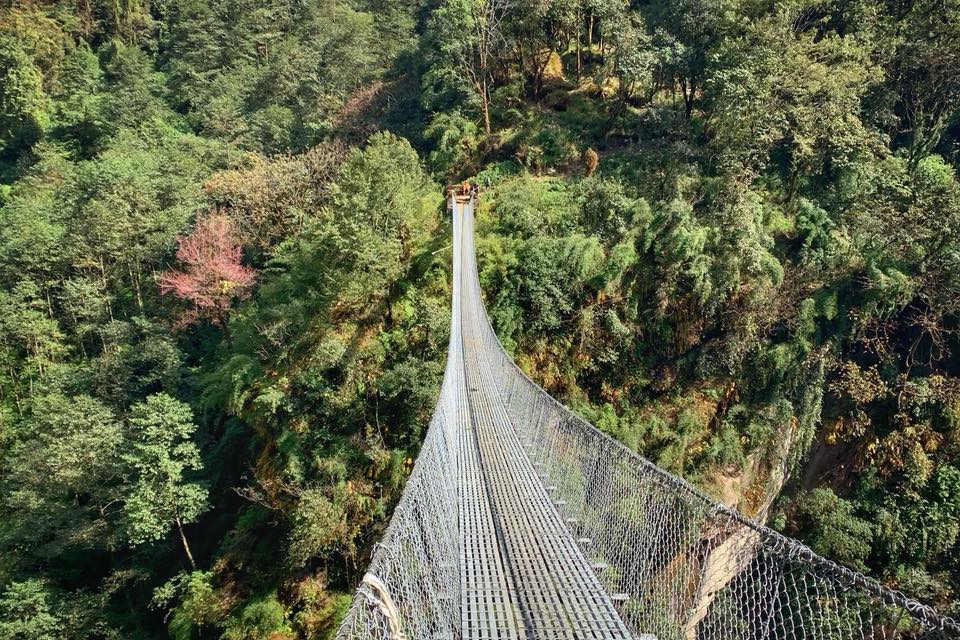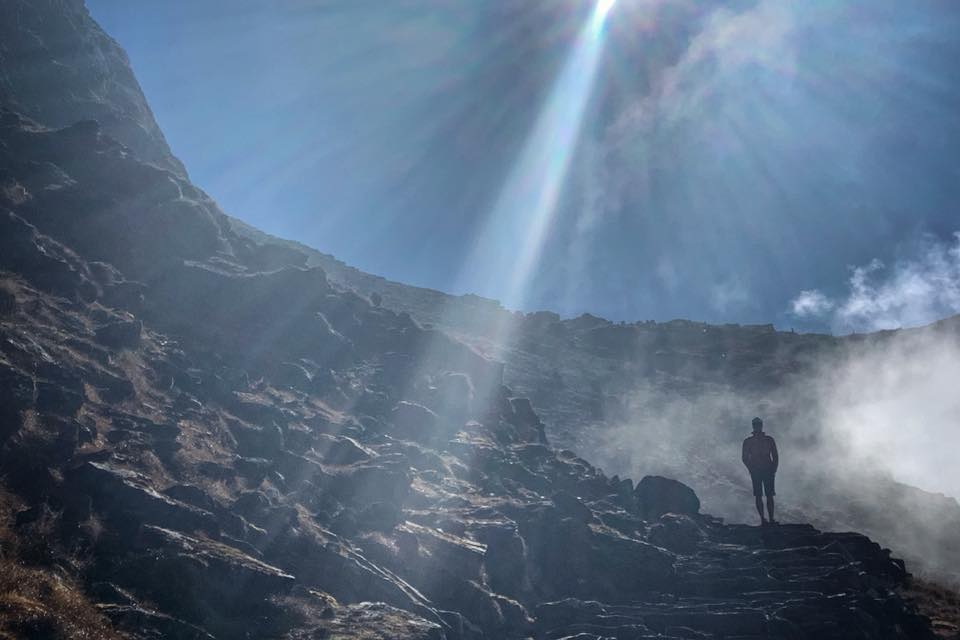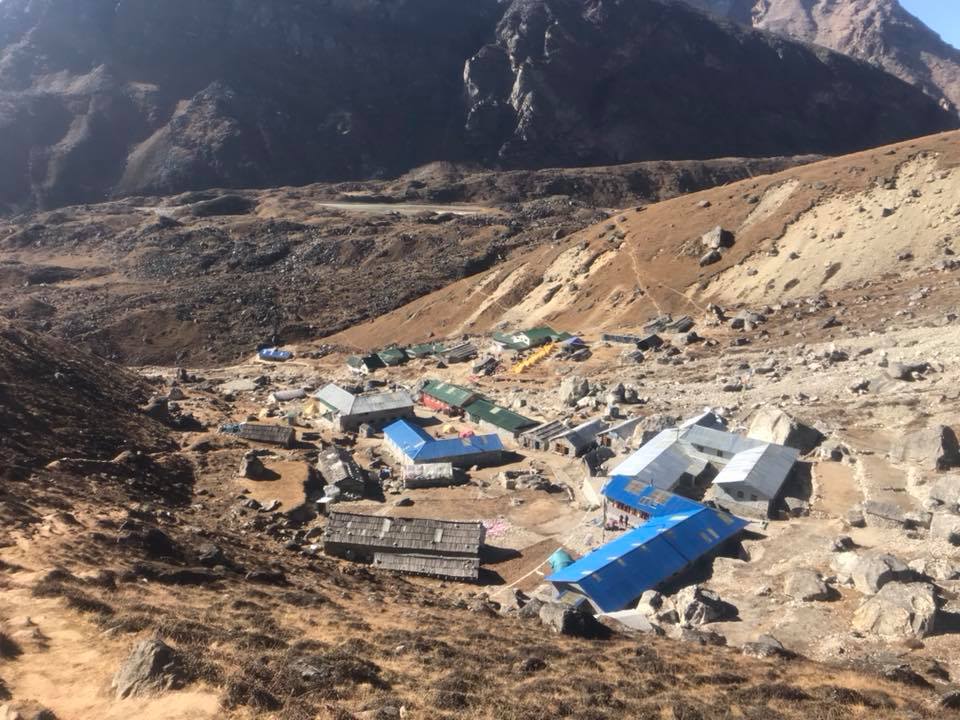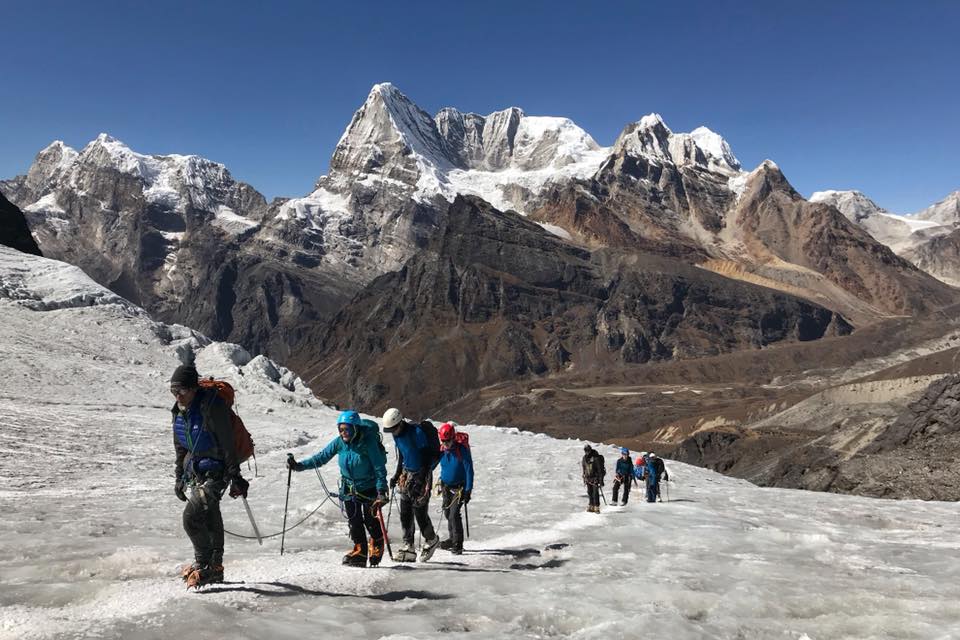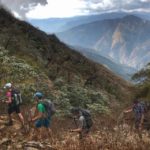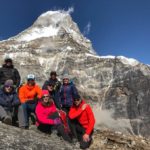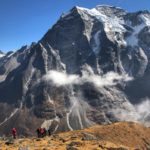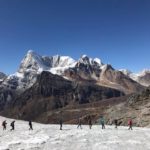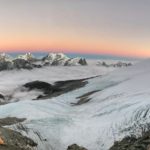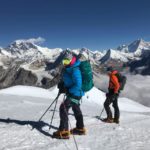Overview
Soaring high into the sky, Mera Peak is a beautiful trek and fantastic climb with a superb alpine feel and outstanding views across the Himalaya!
Mera Peak at 6,476m, is one of the most achievable trekking peaks in the Himalayas. It is a very special expedition where we’ll follow the little-visited jungle route. This route offers incredible views of 5 of the world’s highest mountains, steady acclimatisation and unique cultural insights.
Avoiding the crowds, we’ll trek through the stunningly beautiful Hinku Valley, meeting local hill people in their environment and experiencing the rich Sherpa culture along the way. There’s no rush to acclimatise as you pass through hidden yak pastures, rhododendron forests and stupa-crowned mountain passes. For the summit bid, we enter a land of ice and snow, following the majestic Mera glacier for two days all the way to the top. Our efforts are rewarded with one of the greatest views on Earth, including five mountains, all 8000m+ which span the crown of the Himalayas. Everest, Lhotse, Makalu and Cho Oyu close by, and to the east on the Indian border, Kangchenjunga. It’s a moment to cherish for life.
Organised and lead by Mountain Expeditions
Mountain Expeditions are expedition specialists and the Himalayas are the world’s greatest playground! We love organising and delivering expeditions to Nepal and do so with a friendly and supportive approach. We understand that joining any of our expeditions is a big deal, so we try and make sure everything is perfect from start to finish.
UK Expedition Leader
Mountain Expeditions employ a small number of the UK’s most experienced High Altitude Expedition Leaders and we will always send a UK Expedition Leader to facilitate your expedition. All of our leaders are chosen on their individual merits which we base on their mix of vast mountain experience, interpersonal skills and of course, qualifications.
Local Sherpa Guides
With all our expeditions we partner with the very best local in-country agencies who share our ethos of delivering outstanding expeditions. We believe that a combined leadership team built of a UK Expedition Leader and a highly experienced local Sherpa guide is the strongest and most successful way to deliver our Nepal expeditions. For Mera Peak a local Sherpa guide will be with the team throughout the entire expedition and additional local guides will be used for the summit attempt.
Fully supported by local cooks, porters & guides
The truth behind organising and leading worldwide expeditions is that you need an excellent local in-country agent to work with. Over the years Mountain Expeditions have developed a long standing relationships with our local crew in Nepal and the added value of our friendly and efficient local staff never goes unnoticed – we know it makes a big difference to your experience. Our local team are a huge part of your experience and it makes all the difference on the mountain.
Small teams & personal approach – maximum 8
On big mountains like Mera Peak we don’t believe leading Open Expedition teams of 10+ members is good practice and it certainly doesn’t offer a very personable experience! All our Open Expedition teams are capped at 8 resulting in a close knit, small team experience.
Very high summit success rate
We believe that our summit success rate is down to a combination of smaller teams and using the most experienced High Altitude Expedition Leaders. This combination has shown time and time again that this is the safest approach whilst on the mountain.
21 day itinerary with superb acclimatisation profile
Our itinerary has been chosen to make this trip the very best we believe it can be. We’ve included an entire preparation day in Kathmandu which allows time for people to rest after a long flight, time for any lost luggage to catch up with us and time for your Expedition Leader to do a full kit and medical check before a relaxed expedition briefing with a cold Everest beer! It also allows time for the team to get to know eachother a little before we set off into the mountains together.
A perfect first big mountain or 6000m peak
There are many reasons people choose to climb big mountains and many reasons why you might choose to climb Mera Peak. Mera Peak offers a realistic opportunity to summit a big Himalayan mountain without having vast amounts of altitude experience. Please read our Trip Suitability section to find out more.
Accommodation: Hotel, Tea lodges & tents
Many of our expeditions start and finish in a bustling city in a really nice hotel. Maybe it’s first and last impressions that count or perhaps we just enjoy having nice accommodation to start and finish a trip but it’s what we do! On Mera Peak we use our favourite hotel in Kathmandu, lovely Tea lodges for the trek and we ensure that our Highcamp is as comfortable as possible on the mountain.
Trip Suitability
Mera Peak is open to anyone looking for a real Himalayan adventure. Whilst the mountain poses little technical difficulty, at 6,476m, it is a strenuous climb with some short, steeper sections of 35° snow – we’ve graded it B2 to reflect this (refer to the Difficulty Level tab for more details).
Whilst mountaineering experience would be beneficial, previous experience of using ice axes and crampons is not essential. Mera Peak is ideal for people who have climbed mountains like Kilimanjaro or Elbrus or alternatively, for people who have been on one of our Scottish Winter Courses and are looking for their next expedition.
In preparation for any mountain expedition, we offer Expedition Specific Training courses in both summer and winter. This is a great chance for you spend time in the UK mountains with an experienced Expedition Leader and ask learn some new skills, getting better prepared for you next big expedition objective. If you have booked on to an expedition with us already, then we offer a 10% discount on these courses.
If you are unsure if your experience is suitable for Mera Peak, please don’t hesitate to Contact Us and we’ll discuss it with you in more detail.
Itinerary
The itinerary below is intended as a guideline only, although every effort will be made to adhere to it, changes may be forced upon it by weather conditions, transport failure or other unforeseen events. You should be prepared to be flexible where necessary.
You can download the itinerary as a PDF here.
Day 1: Arrive in Kathmandu.
On arrival into Tribhuvan International Airport you will be met and transferred to our hotel in Thamel. A free day to rest after the flight or explore a little of the fascinating hustling capital city. Evening group meal.
Day 2: Preperation / lesiure day in Kathmandu.
Welcome meeting – 09:00am meet and great for all the team who arrived at different times. Today is our preparation day, so plenty of time for gear checks, questions and picking up last minute bits and pieces. There is also time to sort out local sim cards, write post cards or do some sightseeing to one of many famous sites in Kathmandu.
Day 3: Fly to Lukla (2,840m)
We take the morning flight to the dramatic airfield at Lukla (2,840m), the gateway to the spectacular Nepali Himalayas. At Lukla we meet the sherpas who will be looking after us for the duration of our expedition. We begin our trek south keeping high above the spectacular Dudh Khosi. Lunch will be at Surkhe and then stop for the day at the Sherpa village of Phuiyan (2,796m).
Day 4: Phuiyan (2,796m) – Pangkongma (2,946m)
We set off early and soon climb up to the pass of Khari La (2,990m). The view to the north and the west is fantastic all the way to Cho Oyu. We stop for lunch at a small lodge, seemingly suspended over the wide Kharikhola valley below.
The trail continues through gorgeous forests with many high waterfalls visible before reaching the village of Pangkongma (2,846m). Here we rest near a Sherpa family house, where we catch a glimpse into traditional Sherpa family life.
Day 5: Pangkongma (2,946m) – Narjing Dingma (2,650m)
Another early morning start soon brings us up to the Pangkongma La pass (3,180m), which is marked by some very ancient chortens. From here we enter the Hinku valley and immediately there is a feeling of unspoilt remoteness. After a short hike our objective Mera Peak comes into view standing at the head of the valley. From this angle it looks hugely impressive as its immense walls reach straight out of the valley. We also get our first glimpse of the Hinku River crashing through inaccessible gorges down from the north. The afternoon takes us down a steep path to cross the river, then into deep forests before emerging to rest in the pastures of Narjing Dingma (2,650m).
Day 6: Narjing Dingma (2,650m) – Chalem Kharka (3,450m)
Another spectacular day awaits. We now enter the rhododendron forest and climb Surkie La (3,085m) from where the whole of Eastern Nepal opens out in front of us. Kangchenjunga is visible sometimes from here and below us stretches the remote Hongu valley. We follow the north ridge for the day and spend the night in the grassy pastures at 3,450m.
Day 7: Chalem Kharka (3,450m) – Khula Kharka (4,120m)
Today we continue along the ridge, which in some places narrows dramatically and gullies drop away steeply on either side. One final pass at 4,330m brings us to the five sacred lakes of Panch Pokhari, a pilgrimage site for both Buddhists and Hindus. A short descent from here brings us to our rest point at the small remote and basic settlement of Khula Kharka (4,120m).
Day 8: Khula Kharka (4,120m) – Khote (3,480m)
Today we progress deeper into the Hinku valley to our night’s camp at the established summer village of Khote (3,480m). We pass through the majestic forest and have lunch near a roaring Hinku river. Evidence of the devastation caused by a huge flood when the Sabai Tcho glacial lake broke its moraine dam is clearly visible around us. Mera Peak offers us glimpses of its summit at the end of the valley head.
Day 9: Khote (3,480m) – Tagnak (4360m)
The forest gives way to an open valley and by mid-morning the summits of more 6,000m peaks are revealed. By early afternoon we’ll reach the summer settlement of Tagnak (4360m), where we will spend the night. Towering over our heads the sheer flank of the Mera ridge dramatically dominates the skyline.
Day 10: Tagnak acclimatisation day
We will spend two nights in the village acclimatising to the altitude that we have reached so far. Today we will make an acclimatisation hike up to 5030m on the flanks of Kusum Khangkaru 6370m. The views are spectacular with the huge 2000m west face of Mera, towering summits of Kysar Tangtse 6770, Chamlang 7319m and Peak 41 6648m!
Day 11: Tagnak (4360m) – Khare (4,940m)
This morning’s walk up alongside the Dig glacier is easy and relaxed. We cross the braided river and head into the valley. Dramatic views of the surrounding peaks continue to open up before us. We stop near the village of Khare, our home for two nights. Khare is a beautiful little settlement comprising of a dozen teahouses and an excellent German Bakery!
Day 12: Khare (4,940m) – Mera La (5,410m)
We head up to the start of the Mera Glacier for the first time. Here we will get used to the crampons, roping up, ice axe technique and self-arrest as we get the feel of jumaring on a fixed rope. We will climb a steep ridge onto the back of the Mera Glacier. After a roped-up glacier crossing we make a short descent to the Mera La (5,410m) before heading back to Khare for a good night’s sleep.
Day 13: Khare (4,940m) – Mera High Camp (5,800m)
An incredible day. Heading up from Khare to Highcamp the views that open out beyond are really fantastic: Kanchanjunga, Chamlang, Makalu and Baruntse sweeping around from the east and Ama-Dablam, Cho Oyu and Kangtega to the west slowly but surely come into view.
The giant faces of Everest, Lhotse and Nuptse rise up in the north. The slopes are gently angled and the snow is usually in firm condition. As the altitude increases it will be breathless work to reach the high camp. High camp is on a rock outcrop (5,800m) which separates the Mera from the Naulekh glacier sweeping down from the peaks along the continuous ridge to the south.
Mera High Camp (5800m) has one of the most amazing camp viewpoints in the entire Himalaya. This is a big day but we arrive early afternoon and settle in. This afternoon and evening are really important to your success. Alongside getting hydrated and resting it is important to sort and organise everything for the summit bid.
Day 14: Mera High Camp (5,800m) – Mera summit (6,476m) – Khare (4,940m)
We are woken early by smiling Sherpas offering hot cups of tea and head out into the cold on our way to the summit of Mera Peak. Temperatures are likely to be ten degrees below zero but but will feel much colder due to the altitude, we will soon warm up as we continue up the glacier and onto the snow hump-back ridge. The first rays of the sun hit the big peaks in an amazing red glow. The route is still non-technical as we climb slowly, but surely higher into the ever-thinning air. The slope steepens for a section behind the ridge and the summit comes back into view. At the foot of the final steep summit cone, we may attach to a fixed rope depending on conditions. The summit is only a few metres away. Shortly ahead is that moment we have all been working so hard to achieve: the summit itself. It’s a moment that is unforgettable. Before us lies the 360° panorama that is simply the best from all the Himalayan peaks. Only this summit can boast such a spectacle. We spend some time taking it all in before we finally descend back down to Khare where we have a well-deserved round of celebratory drinks!
Day 16: Khare (4,940m) – Khote (3,840m)
We retrace our steps back down the valley and alongside the Dig Glacier before passing back through Tagnak where we have our last good view of Mera before reaching Khote where we will spend the night.
Day 17: Khote (3,840m) – Chetera (4,100m)
A new route has now been completed which stays high on the open hillsides west of the Hinku River making for a quicker return with some fantastic views back on Mera itself from a completely different angle. We spend the night at Chetera (4,100m), a small pastoral settlement.
Day 18: Chetera (4,100m) – Lukla (2,840m)
The trail climbs to the Zatrawa La (4,580m) from where we get the last views of the mighty peak we have just climbed. From here we traverse to the rocky outcrop of the Zatr Og before descending steeply down into the Sherpa populated Dudh Kosi valley. We reach the tourist bustle of Lukla (2,840m) by late afternoon and spend the night. A celebration dinner at the tea lodge and a few drinks at the local bars is usually on the cards.
Day 19: Fly to Kathmandu
The scenic morning flight back to Kathmandu gives us one last chance to say farewell to the mountains. We will have a tour of the city in the afternoon before celebrating our huge achievement with a special dinner.
Day 20: At leisure in Kathmandu / Fly home
A final chance to explore the bustling capital, with its beautiful temples and bustling markets, or take the transfer back to the airport and your flight back to the UK.
Map
Included
When you book with Mountain Expeditions, we want you to know exactly how much the trip is going to cost you, with absolutely no hidden extras or last-minute costs. Our fully inclusive land-only price includes almost everything from the minute you land at Kathmandu International Airport until the time when we drop you back – there are no hidden extras!
The following are included in our price:
- A UK Expedition Leader who has extensive high altitude experience
- Local Sherpa Guides, Assistant Guides and Porters
- All in-country airport transfers
- All in-country meals – including our celebration meal!
- 3 nights hotel accommodation in Kathmandu (2 nights before, 1 after)
- Tea house accommodation during the trek
- All group equipment (4-season tents for highcamp, cookers etc.)
- Lukla domestic flights (plus taxes)
- All trekking permits and fees
- Emergency equipment – comprehensive first aid kit, medicine, oxygen and radios
You should also refer to the Not Included section.
Not Included
The following are NOT included in our price:
- International Flights to Kathmandu International Airport (KTM)
- Nepal visa, $30 USD
- Travel insurance
- Tips $160 USD
- Personal spending money
- Drinks from the bar(s)
- Pre-trip inoculations
- Personal clothing & equipment – please refer to the Kit List
- Wi-Fi in Tea Lodges
- Items of a personal nature – phone calls, laundry, room service, alcoholic beverages etc.
- Unscheduled hotels and restaurant meals e.g. if bad weather grounds flights
- Any additional costs associated with leaving the expedition early
Difficulty Level
All of our UK Courses & Worldwide Expeditions come with a suggested difficulty level to help you choose the correct one. For a full explanation of the Scottish Winter, Alpine and UK Rock Climbing grading systems, this blog explains them all – Grades Explained
Grading for UK Courses
With all our UK courses please refer to the Trip Suitability section for more specific details on course expectation and technical and physical levels required.
C1 – Intro Course: open to any level and ability
C2 – Intermediate Courses: previous experience of scrambling/rock climbing or winter mountaineering
C3 – Advanced Courses: previous technical summer or winter climbing experience
Grading for Worldwide Expeditions
With all our Worldwide Expeditions you should refer to the Trip Suitability section for more specific details on the expedition expectation and technical and physical levels required. If in any doubt please don’t hesitate to contact us.
Physical
A. Good basic fitness, as for UK hill walking and mountaineering. Average rucksack weight: 6-8 kg
B. Good cardio-vascular fitness which for most people requires some training, by running, hiking and perhaps some gym work. Average rucksack weight: 8-12 kg.
C. High level of fitness coupled with physical toughness and the ability to carry a heavy rucksack for long periods. Average rucksack weight: 12-18 kg.
D. As for C, but tougher. Climbs of this grade are exceptionally strenuous and some weight loss is inevitable. Train hard and arrive fit. Welcome to ask for advice if training specifically.
E. Hard physical effort at extreme altitude which requires thorough preparation based on your experience of previous trips. Comments for ‘D’ also apply. May cause long-term fatigue after the trip.
Technical
1. Low angle snow or straightforward scrambling on rocks. Ropes are not usually required. Previous climbing experience is not essential.
2. Ropes are used principally for glacier travel and low angle snow or ice slopes. Ice axe and crampon experience necessary.
3. Short, steep sections of snow or ice up to about 50 degrees. Previous snow and ice climbing experience of Scottish III/Alpine PD is essential.
4. Long, steep snow and ice slopes with short steps of very steep ice or low grade rock climbing. Good all-round climbing ability required to Scottish III/Alpine AD.
5. Very steep ice (Scottish III/IV or harder) or rock (Hard Severe or harder). Suitable for competent mountaineers who have climbed consistently at these standards.
In-country Safety
Government Advice
We support the British Foreign & Commonwealth Office (FCO) ‘Know Before You Go’ campaign and recommend that you have a good read of the FCO Travel Advice for Nepal.
24/7 Expedition Medical Advisors
We work very closely with two specialist Expedition Medical Advisors (EMA’s). If you have any concerns about how your health conditions may be affected whilst in the mountains with us, you are welcome to talk with our EMA’s prior to your trip – all you need to do is let us know and we’ll put you in touch. Whilst on expedition our EMA’s are contactable 24/7 to provide our leaders with advice or assistance during any arising medical situation.
Emergency Operation Procedures
We work very hard to ensure we have a clear plan for all eventualities that may arise during the expedition. Liaising with local agencies including mountain rescue means we adhere to local regulations, have a clear evacuation process and ensure all the ‘what ifs’ are covered.
Risk Assessments & British Standards
Whilst expeditions to big mountains have inherent objective risks, we do our very best to mitigate these risks as much as possible. Careful planning and thorough consideration of all aspects of the trip means that there are very few surprises. We take advice and guidance from the British Standards BS8848 publication as well as from our experienced leaders and local agents.
FAQs
Do I need a visa for Nepal?
All foreign nationals need visas which are easily obtained at the airport. If you have time however, we recommend that you contact your nearest Nepali embassy to obtain for your visa before you travel.
What vaccinations do I need?
Please visit your GP or a specialist travel clinic e.g. Nomad Travel and ask for their advice on vaccinations.
Do I need special travel insurance for Mera Peak?
You must have individual travel insurance to join all of our expeditions.
It is your responsibility to ensure that you have the appropriate insurance for your intended trip. For Mera Peak it needs to include medical evacuation and coverage up to the maximum altitude of 6500m.
Once you have taken out your trip insurance please input your details in to the My Details section within 'My Account'
What happens if there is a problem on the mountain?
Our highly experienced Expedition Leaders will manage any situation that arises with the assistance of our local Sherpa Guide. Our local team are very experienced in dealing with all manner of problems. With high guide to client ratios we can safely manage any problem quickly and efficiently.
In Nepal we have the very best agent supporting our treks and helicopters are on standby should they be required.
Is it possible to hire/rent equipment before I go?
Kit can be hired from us directly or from local shops in both Kathmandu and Khare (the highest village on the trek) depending on what the item is.
Do let us know if you need any hire kit for the expedition and we'll advise on the best place for you to hire it from.
What is the food like at high camp?
The meals at high camp are prepared by our Sherpa Team. They will be fresh, nutritious and plentiful! You’ll be amazed what can be produced on a kerosene stove at nearly 6000m!
On top of the meals you are provided with tea and snacks on arrival into camp. The morning wake-up call is usually accompanied by a cup of tea or coffee in your tent.
You are welcome to bring along any of your favourite snacks and goodies from home if you want. High energy, slow release to give you that little boost on summit day.
If you have any dietary requirements, please let us know before hand.
Do we need a travel adaptor for the plug sockets in the hotel or are they the same as UK?
Nepal uses both round 2 pin and round 3 pin plugs (UK), an adaptor can be purchased at the airport if you’ve forgotten it.
Will I be able to charge a camera or phone on the trek?
Opportunities to charge your batteries may be limited but possible at the Tea Lodges. Your best option is to bring a personal powerbank and potentially a solar power charger to keep yourself topped up.
Also make sure that you keep your spare batteries warm i.e. by keeping them near your body day and night.
Is there mobile phone reception on the trek?
In Nepal, telephones and internet access are readily available in Kathmandu but limited in the mountains. The quality of the phone reception varies from location to location but is generally poor on the trek.
Many of the Tea Lodges have Wi-Fi now although this costs roughly $10 per hour!
How much do we tip our local crew?
As a general rule we suggest around $160 per client for the entire local crew to be shared amongst them. The Expedition Leader will manage this for the team.
Our local crew work extremely hard to ensure that your expedition runs perfectly. Although tipping is not compulsory, once you see how hard the crew works tipping will seem the least you can do to say thank you.
What additional spending money will we need?
In Kathmandu you will require additional money for any kit hire costs, beers and personal shopping.
Mera Peak - during the trek you will want to have some local currency with you to pay for things like Wi-Fi, Coke, Pringles & visits to the occasional bakery! Wi-Fi is quite expensive in the Tea Lodges so we recommend £15 per day (in local currency) to cover any extras you may want.





